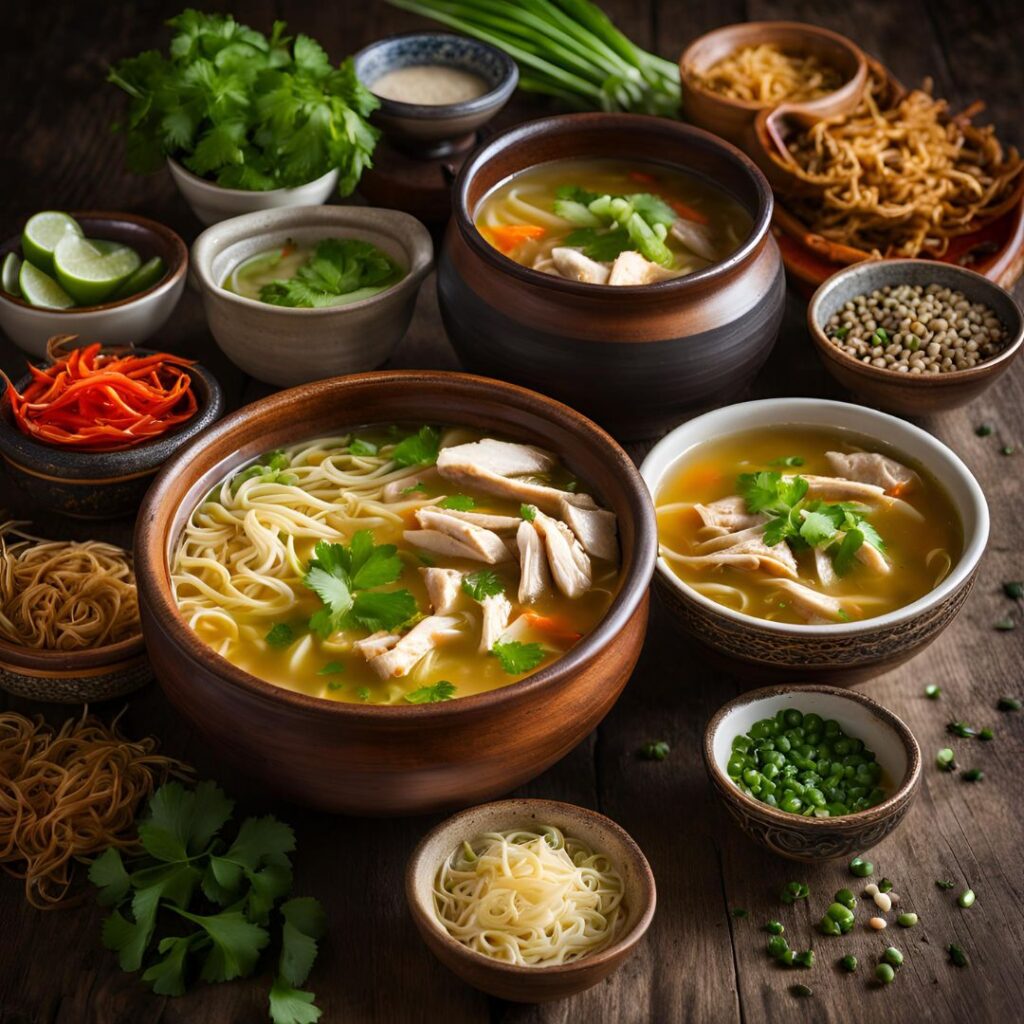

Chicken Noodle Soup Recipe : symbol of nourishment, comfort, and simplicity. There’s a reason why chicken noodle soup holds a special place in our hearts. It’s the dish we crave when we’re feeling under the weather, the meal that brings a sense of warmth on cold days, and a nostalgic reminder of home-cooked goodness. Universally beloved and deeply ingrained in food cultures across the world, chicken noodle soup is more than just a simple recipe; it’s a symbol of nourishment, comfort, and simplicity.
The appeal of chicken noodle soup lies not just in its flavor, but in its versatility and ease of preparation. Whether it’s a light broth-based version filled with fresh vegetables and tender noodles, or a heartier stew with chunks of succulent chicken and rich, flavorful stock, the dish is easily customizable to suit individual tastes. The simplicity of ingredients belies the depth of flavor that can be achieved, making it a staple in kitchens globally.
This article will explore the history of chicken noodle soup, its significance as a comfort food, and how a classic recipe can be adapted to suit modern tastes. By the end, you’ll have a deeper appreciation for this humble dish, as well as a detailed recipe to create your own version at home.
The origins of chicken noodle soup are difficult to trace precisely, but variations of this beloved dish can be found in nearly every culture that consumes chicken. The Chinese have been preparing soups with noodles and chicken for centuries, a practice that likely dates back to ancient times when noodles were first invented. In Jewish culture, chicken soup, often referred to as “Jewish penicillin,” has long been a traditional dish, especially during holidays like Passover, where it’s served with matzo balls.
In Europe, the combination of chicken and noodles also has a long history, with different countries developing their own versions of the dish. From Poland’s rosol to Italy’s brodo di pollo, chicken soup is universally regarded as both food for the body and soul. However, it was the commercialization of canned chicken noodle soup by the Campbell Soup Company in the early 20th century that really cemented the dish's place in American culinary tradition. What started as "Chicken with Noodles" on a soup can label became the iconic "Chicken Noodle Soup," and since then, it has been a favorite comfort food in homes across the United States.
When we think of comfort food, chicken noodle soup is often the first dish that comes to mind. The very idea of comfort food is associated with feelings of warmth, security, and relief, and few dishes embody those qualities as well as chicken noodle soup. Its simplicity is part of its charm. Made from basic, wholesome ingredients like chicken, vegetables, broth, and noodles, it’s a dish that is easy to prepare yet feels deeply nourishing. It’s light enough to eat when you’re feeling unwell, but still hearty enough to be a satisfying meal at any time.
The healing properties of chicken soup have been touted for generations. Historically, mothers and grandmothers would prepare a batch of soup to ward off colds and illnesses, a practice that continues to this day. While the claim that chicken noodle soup can cure the common cold might be an overstatement, research does suggest that the hot broth can help clear nasal congestion and ease the symptoms of upper respiratory infections. Additionally, the soup’s hydrating properties, combined with the vitamins and nutrients from vegetables and chicken, make it an ideal dish for recuperation.
Beyond physical nourishment, there’s an emotional connection that many people feel when they enjoy a bowl of chicken noodle soup. It’s often associated with memories of home, family meals, and care during times of sickness or stress. This emotional resonance only adds to its status as the ultimate comfort food.
At its core, chicken noodle soup consists of four main components: chicken, broth, vegetables, and noodles. The simplicity of these ingredients is part of what makes the dish so adaptable and appealing. However, each element plays an essential role in creating the perfect balance of flavors and textures.
Chicken: The star of the dish, chicken adds protein and richness. Most recipes call for boneless, skinless chicken breasts or thighs, but whole chickens can also be used for a more flavorful broth. Whether you prefer the lean texture of white meat or the juiciness of dark meat, the choice of chicken can significantly influence the overall taste and texture of the soup.
Broth: The foundation of the soup is a well-seasoned broth. Homemade chicken broth, made by simmering chicken bones, onions, carrots, celery, and herbs, provides the best flavor. However, store-bought chicken broth or stock is a convenient alternative and can still produce a delicious soup. The quality of the broth is key to the depth of flavor, so using a low-sodium or organic variety is recommended if you're opting for store-bought.
Vegetables: Traditional vegetables like carrots, celery, and onions (often called the "holy trinity" of soup-making) not only add flavor but also contribute essential nutrients. Some recipes also incorporate garlic, peas, or other vegetables, depending on personal preference or regional variations.
Noodles: Egg noodles are the classic choice for chicken noodle soup, but other types of pasta such as orzo, rotini, or even rice can be used for a different texture. The noodles should be cooked just until tender, as they continue to absorb the broth and can become too soft if overcooked.
One of the best things about chicken noodle soup is how easily it can be adapted. Depending on your preferences or dietary needs, the recipe can be modified in countless ways:
The versatility of chicken noodle soup also extends to its seasoning. Herbs like thyme, parsley, and bay leaves are commonly used, but you can experiment with other herbs and spices such as rosemary, dill, or turmeric to create a unique flavor profile.
Chicken noodle soup is more than just a meal—it’s an experience. Whether you’re sipping on a bowl to stave off the flu, enjoying a cozy night in, or simply looking for a quick and delicious homemade meal, this classic dish delivers every time. Its universal appeal, ease of preparation, and nourishing qualities make it a beloved staple across kitchens worldwide. So next time you’re in need of a comforting bowl of warmth, you know exactly what to make: a classic chicken noodle soup that’s sure to satisfy both body and soul.
Whether you're cooking for your family, friends, or just yourself, chicken noodle soup is one recipe you'll always return to—because no matter how times change, some things never go out of style.
In a large pot, heat olive oil over medium heat. Add the chicken and season with salt and pepper. Cook for about 6-8 minutes on each side until fully cooked through. Remove the chicken, shred or chop it, and set aside.
In the same pot, add the diced onion, carrots, and celery. Sauté for 5-6 minutes until softened. Add minced garlic and cook for another minute until fragrant.
Add chicken broth, bay leaf, thyme, and shredded chicken to the pot. Bring the soup to a boil, then reduce the heat and let it simmer for 15-20 minutes to allow the flavors to meld.
Add egg noodles to the simmering soup. Cook for another 8-10 minutes or until the noodles are tender. Check seasoning and add more salt or pepper if needed.
Remove the bay leaf and stir in lemon juice for a fresh zing (optional). Garnish with fresh parsley if desired.
Number of Servings: 4-6 servings
Yes! Rotisserie chicken is a great time-saver. Simply shred the cooked chicken and add it during the last few minutes of cooking to warm it through. This eliminates the need to cook raw chicken separately, speeding up the recipe while still providing delicious flavor.
To avoid mushy noodles in this Chicken Noodle Soup Recipe, cook them separately from the soup, especially if you're making a large batch or plan to store leftovers. Add the noodles to individual servings just before eating. If cooking them in the soup, undercook the noodles slightly, as they’ll continue to absorb liquid after being added to the broth.
Yes, but with one adjustment: It’s best to freeze the soup without the noodles, as they tend to get mushy after freezing and thawing. When reheating, you can cook fresh noodles separately and add them to the soup. Store the soup in airtight containers, leaving a little room at the top for expansion.
Both chicken breasts and thighs work well, but thighs are often preferred for their richer flavor and tenderness. Boneless, skinless cuts are easier to use, but if you want more flavor in your broth, you can use bone-in chicken and remove the bones later.
Absolutely! To make this Chicken Noodle Soup Recipein a slow cooker, add all ingredients except the noodles and cook on low for 6-8 hours or on high for 3-4 hours. Shred the chicken once it's fully cooked, then add the noodles about 20-30 minutes before serving to prevent them from becoming too soft.
You can easily boost the flavor of store-bought broth by simmering it with additional ingredients like fresh garlic, onions, carrots, celery, bay leaves, and fresh herbs. A splash of soy sauce or a teaspoon of miso paste can also deepen the flavor. For extra richness, add a bit of butter or olive oil.
Yes! This recipe of Chicken noodle soup is a great make-ahead meal. Just remember to cook the noodles separately and add them when reheating. You can refrigerate the soup for 3-4 days or freeze it (without noodles) for up to 3 months.
Besides the classic carrots, onions, and celery, you can add vegetables like peas, spinach, kale, zucchini, or even corn to this Chicken Noodle Soup Recipe. Leafy greens should be added toward the end of cooking so they don’t overcook and lose their color.
To prevent dry chicken, avoid overcooking it. If using raw chicken, simmer it gently until just cooked through (internal temperature of 165°F/75°C), then remove it from the soup, shred or chop, and return it just before serving. This ensures the chicken stays juicy and tender.
Chicken noodle soup is typically dairy-free unless you're adding cream or butter. If a creamier texture is desired, you can use coconut milk or a dairy-free alternative. Just be sure to use oil (such as olive or avocado oil) instead of butter for sautéing the vegetables.
If you prefer a thicker soup, you can add a slurry made of cornstarch and water (1-2 tablespoons of cornstarch mixed with equal parts water). Stir it into the soup in the last few minutes of cooking and simmer until it reaches the desired consistency. Alternatively, blend a portion of the vegetables and broth for a naturally thicker texture.
For this Chicken Noodle Soup Recipe , a squeeze of fresh lemon juice or a splash of vinegar added at the end of cooking can really brighten the flavors. You can also garnish with fresh herbs like parsley, dill, or cilantro to enhance freshness just before serving.
Whether you’re sipping on a bowl to stave off the flu, enjoying a cozy night in, or simply looking for a quick and delicious homemade meal, this classic dish delivers every time. Its universal appeal, ease of preparation, and nourishing qualities make it a beloved staple across kitchens worldwide. So next time you’re in need of a comforting bowl of warmth, you know exactly what to make: a classic chicken noodle soup that’s sure to satisfy both body and soul.
Enjoy the yum :)